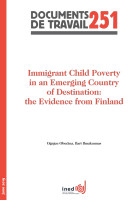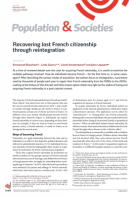
Immigrant Child Poverty in an Emerging Country of Destination: the Evidence from Finland
Collection : Documents de travail
n° 251, 2019, 20 pages
The aim of this paper is to analyze the patterns of poverty and housing overcrowding among immigrant children in Finland, with a particular focus on the standard of living in the first years of settlement. We also seek to explore whether and to what degree foreign-born children are disadvantaged relative to native children in terms of income poverty and housing conditions. We use data from a compilation of Finnish registers. The registers are of longitudinal nature and contain yearly information on all individuals who resided in Finland at any point between 1995 and 2014. We distinguish between four different types of poverty trajectories in the first five years after arrival in Finland: 1) no experience of poverty, 2) not poor in at least three out of five years, 3) poor in at least three out of five years, and 4) poor in all five years. An analogous classification is applied when looking at housing overcrowding. The relative disadvantage of immigrant children relative to native children is more pronounced in terms of income poverty than in terms of housing. The most frequent outcome in terms of income poverty in the first years of settlement is no experience of poverty, followed by persistent poverty, i.e. poverty in all five years after arrival. The same patterns are found for overcrowding. The multivariate analysis, based on the ordered logistic regression, shows a substantial heterogeneity across immigrant groups defined by country of birth
- Ilari Ilmakunna








